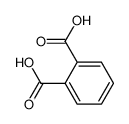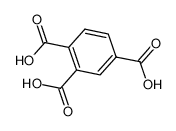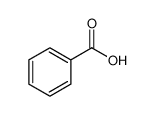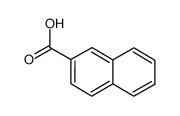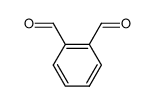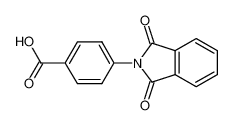| Product name | phthalic acid |
|---|
| Product number | - |
|---|---|
| Other names | 1,2-Benzenedicarboxylic acid |
| Identified uses | For industry use only. Metabolite |
|---|---|
| Uses advised against | no data available |
| Company | MOLBASE (Shanghai) Biotechnology Co., Ltd. |
|---|---|
| Address | Floor 4 & 5, Building 12, No. 1001 North Qinzhou Road, Xuhui District, Shanghai, China |
| Telephone | +86(21)64956998 |
| Fax | +86(21)54365166 |
| Emergency phone number | +86-400-6021-666 |
|---|---|
| Service hours | Monday to Friday, 9am-5pm (Standard time zone: UTC/GMT +8 hours). |
Serious eye damage, Category 1
2.2 GHS label elements, including precautionary statements| Pictogram(s) | 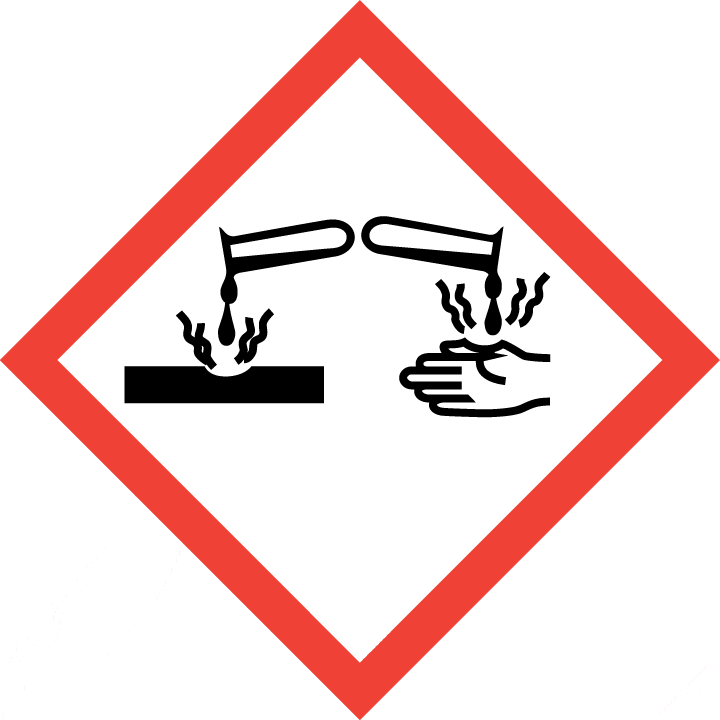 |
|---|---|
| Signal word | Danger |
| Hazard statement(s) | H318 Causes serious eye damage |
| Precautionary statement(s) | |
| Prevention | P280 Wear protective gloves/protective clothing/eye protection/face protection. |
| Response | P305+P351+P338 IF IN EYES: Rinse cautiously with water for several minutes. Remove contact lenses, if present and easy to do. Continue rinsing. P310 Immediately call a POISON CENTER/doctor/… |
| Storage | none |
| Disposal | none |
none
3.Composition/information on ingredients 3.1 Substances| Chemical name | Common names and synonyms | CAS number | EC number | Concentration |
|---|---|---|---|---|
| phthalic acid | phthalic acid | 88-99-3 | none | 100% |
Consult a physician. Show this safety data sheet to the doctor in attendance.
If inhaledFresh air, rest.
In case of skin contactRinse and then wash skin with water and soap.
In case of eye contactRinse with plenty of water for several minutes (remove contact lenses if easily possible).
If swallowedRinse mouth.
4.2 Most important symptoms/effects, acute and delayedSYMPTOMS: Symptoms of exposure to this compound may include irritation of the skin, eyes, mucous membranes, and respiratory passages. In high concentrations, it can cause narcosis. ACUTE/CHRONIC HAZARDS: This compound is an irritant of the skin, eyes, mucous membranes, and respiratory tract. It is narcotic in high concentrations. When heated, it decomposes to a compound which in the form of dust is an explosion hazard. Hazardous decomposition products include carbon oxides.
4.3 Indication of immediate medical attention and special treatment needed, if necessaryInhalation Exposure: Fresh air, rest. Skin Exposure: Remove contaminated clothes. Rinse and then wash skin with water and soap. Eye exposure: First rinse with plenty of water for several minutes (remove contact lenses if easily possible), then take to a doctor. Ingestion: Rinse mouth.
5.Fire-fighting measures 5.1 Extinguishing media Suitable extinguishing mediaPowder, water spray, foam, carbon dioxide.
5.2 Specific hazards arising from the chemicalThis chemical is combustible.
5.3 Special protective actions for fire-fightersWear self-contained breathing apparatus for firefighting if necessary.
6.Accidental release measures 6.1 Personal precautions, protective equipment and emergency proceduresUse personal protective equipment. Avoid dust formation. Avoid breathing vapours, mist or gas. Ensure adequate ventilation. Evacuate personnel to safe areas. Avoid breathing dust. For personal protection see section 8.
6.2 Environmental precautionsPersonal protection: particulate filter respirator adapted to the airborne concentration of the substance. Sweep spilled substance into covered containers. If appropriate, moisten first to prevent dusting. Wash away remainder with plenty of water.
6.3 Methods and materials for containment and cleaning upSweep spilled substance into containers; if appropriate, moisten first to prevent dusting (extra personal protection: P1 filter respirator for inert particles).
7.Handling and storage 7.1 Precautions for safe handlingAvoid contact with skin and eyes. Avoid formation of dust and aerosols. Avoid exposure - obtain special instructions before use.Provide appropriate exhaust ventilation at places where dust is formed. For precautions see section 2.2.
7.2 Conditions for safe storage, including any incompatibilitiesStore in cool place. Keep container tightly closed in a dry and well-ventilated place.
8.Exposure controls/personal protection 8.1 Control parameters Occupational Exposure limit valuesno data available
Biological limit valuesno data available
8.2 Appropriate engineering controlsHandle in accordance with good industrial hygiene and safety practice. Wash hands before breaks and at the end of workday.
8.3 Individual protection measures, such as personal protective equipment (PPE) Eye/face protectionSafety glasses with side-shields conforming to EN166. Use equipment for eye protection tested and approved under appropriate government standards such as NIOSH (US) or EN 166(EU).
Skin protectionWear impervious clothing. The type of protective equipment must be selected according to the concentration and amount of the dangerous substance at the specific workplace. Handle with gloves. Gloves must be inspected prior to use. Use proper glove removal technique(without touching glove's outer surface) to avoid skin contact with this product. Dispose of contaminated gloves after use in accordance with applicable laws and good laboratory practices. Wash and dry hands. The selected protective gloves have to satisfy the specifications of EU Directive 89/686/EEC and the standard EN 374 derived from it.
Respiratory protectionWear dust mask when handling large quantities.
Thermal hazardsno data available
9.Physical and chemical properties| Physical state | white crystals |
|---|---|
| Colour | Colorless crystals |
| Odour | no data available |
| Melting point/ freezing point | 210°C(lit.) |
| Boiling point or initial boiling point and boiling range | 155°C/0.5mmHg(lit.) |
| Flammability | Combustible. |
| Lower and upper explosion limit / flammability limit | no data available |
| Flash point | 88°C(lit.) |
| Auto-ignition temperature | no data available |
| Decomposition temperature | 191°C |
| pH | no data available |
| Kinematic viscosity | no data available |
| Solubility | In water:7 g/L (25 ºC) |
| Partition coefficient n-octanol/water (log value) | no data available |
| Vapour pressure | 6.36X10-7 mm Hg at 25°C |
| Density and/or relative density | 1.451 g/cm3 |
| Relative vapour density | 5.73 (AIR= 1) |
| Particle characteristics | no data available |
no data available
10.2 Chemical stabilityStable under recommended storage conditions.
10.3 Possibility of hazardous reactionsCombustible when heated.Dust explosion possible if in powder or granular form, mixed with air.PHTHALIC ACID is a carboxylic acid. This chemical is sensitive to exposure to extreme heat. This compound reacts violently with nitric acid. It is incompatible with sodium nitrite. It is also incompatible with oxidizers. .
10.4 Conditions to avoidno data available
10.5 Incompatible materialsMixtures of sodium nitrite and phthalic acid or phthalic anhydride explode violently on heating. A nitrite ester may have been produced.
10.6 Hazardous decomposition productsWhen heated to decomposition it emits acrid smoke and irritating fumes.
11.Toxicological information Acute toxicity- Oral: LD50 Mouse oral 2,530 mg/kg
- Inhalation: no data available
- Dermal: no data available
no data available
Serious eye damage/irritationno data available
Respiratory or skin sensitizationno data available
Germ cell mutagenicityno data available
Carcinogenicityno data available
Reproductive toxicityno data available
STOT-single exposureno data available
STOT-repeated exposureno data available
Aspiration hazardno data available
12.Ecological information 12.1 Toxicity- Toxicity to fish: no data available
- Toxicity to daphnia and other aquatic invertebrates: no data available
- Toxicity to algae: no data available
- Toxicity to microorganisms: no data available
AEROBIC: After an acclimation of an activated sludge inoculum for 24 days, 95% of phthalate was consumed in a respiratory test(1). Phthalic acid completely degraded in 2 days in a screening test using a soil inoculum(2). Over 99% primary degradation was obtained in the semicontinuous activated sludge test of the Soap and Detergent Association(3). Degradation by some microorganisms is impeded when phthalic acid is adsorbed on particles such as aluminum oxide(4). Five day BOD studies have shown 78% degradation of phthalic acid(5). A biodegradation rate constant for phthalic acid of 1.56/day was measured in river water corresponding to a half life of 10.7 hrs(6). A half life of 2 days was measured in sludge amended soil(7). Phthalic acid rapidly degraded in Chalmers soil (1.96% organic carbon, pH 6.0); 100% decomposition, as determined by C02 evolution, was obtained after 53 days(8). In a river die-away test using water from the Mississippi River at St Louis, phthalic acid completely disappeared in 2.5 and 5 wks at concns of 12.5 and 50 mg/L, respectively(9). In another river die-away test using Missouri River water and carboxyl-labeled 14C-phthalic acid, 66-92% mineralization was obtained in 32 days(10). Bacteria that grew aerobically on phthalic acid were found in sediment and water from the estuary of the Mississippi River indicating the potential for phthalic acid biodegradation in the marine environment(11).
12.3 Bioaccumulative potentialAn estimated BCF of 3 was calculated for phthalic acid(SRC), using a log Kow of 0.73(1) and a regression-derived equation(2). According to a classification scheme(3), this BCF suggests the potential for bioconcentration in aquatic organisms is low(SRC).
12.4 Mobility in soilThe Koc values were determined for an acidic forest soil (Podzol, 4.85% organic carbon, pH 2.8), an agricultural soil (Alfisol, 1.25% organic carbon, pH 6.7) and a sublimnic soil (sediment from Lake Constance, Germany, 1.58% organic carbon, pH 7.1) as 31, 2 and 2, respectively(1). According to a classification scheme(2), these Koc values suggest that phthalic acid is expected to have very high mobility in soil. Phthalic acid adsorbs strongly to aluminum and iron oxides via a surface ligand exchange reaction(3). Adsorptivity is sensitive to pH; for aluminum oxide the fraction absorbed is >0.8 below pH 6 and falls below 0.1 above pH 7.5(3).
12.5 Other adverse effectsno data available
13.Disposal considerations 13.1 Disposal methods ProductThe material can be disposed of by removal to a licensed chemical destruction plant or by controlled incineration with flue gas scrubbing. Do not contaminate water, foodstuffs, feed or seed by storage or disposal. Do not discharge to sewer systems.
Contaminated packagingContainers can be triply rinsed (or equivalent) and offered for recycling or reconditioning. Alternatively, the packaging can be punctured to make it unusable for other purposes and then be disposed of in a sanitary landfill. Controlled incineration with flue gas scrubbing is possible for combustible packaging materials.
14.Transport information 14.1 UN Number| ADR/RID: Not dangerous goods. | IMDG: Not dangerous goods. | IATA: Not dangerous goods. |
| ADR/RID: unknown |
| IMDG: unknown |
| IATA: unknown |
| ADR/RID: Not dangerous goods. | IMDG: Not dangerous goods. | IATA: Not dangerous goods. |
| ADR/RID: Not dangerous goods. | IMDG: Not dangerous goods. | IATA: Not dangerous goods. |
| ADR/RID: no | IMDG: no | IATA: no |
no data available
14.7 Transport in bulk according to Annex II of MARPOL 73/78 and the IBC Codeno data available
15.Regulatory information 15.1 Safety, health and environmental regulations specific for the product in question| Chemical name | Common names and synonyms | CAS number | EC number |
|---|---|---|---|
| phthalic acid | phthalic acid | 88-99-3 | none |
| European Inventory of Existing Commercial Chemical Substances (EINECS) | Listed. | ||
| EC Inventory | Listed. | ||
| United States Toxic Substances Control Act (TSCA) Inventory | Listed. | ||
| China Catalog of Hazardous chemicals 2015 | Not Listed. | ||
| New Zealand Inventory of Chemicals (NZIoC) | Listed. | ||
| Philippines Inventory of Chemicals and Chemical Substances (PICCS) | Listed. | ||
| Vietnam National Chemical Inventory | Listed. | ||
| Chinese Chemical Inventory of Existing Chemical Substances (China IECSC) | Listed. | ||
| Creation Date | Aug 12, 2017 |
|---|---|
| Revision Date | Aug 12, 2017 |
- CAS: Chemical Abstracts Service
- ADR: European Agreement concerning the International Carriage of Dangerous Goods by Road
- RID: Regulation concerning the International Carriage of Dangerous Goods by Rail
- IMDG: International Maritime Dangerous Goods
- IATA: International Air Transportation Association
- TWA: Time Weighted Average
- STEL: Short term exposure limit
- LC50: Lethal Concentration 50%
- LD50: Lethal Dose 50%
- EC50: Effective Concentration 50%
- IPCS - The International Chemical Safety Cards (ICSC), website: http://www.ilo.org/dyn/icsc/showcard.home
- HSDB - Hazardous Substances Data Bank, website: https://toxnet.nlm.nih.gov/newtoxnet/hsdb.htm
- IARC - International Agency for Research on Cancer, website: http://www.iarc.fr/
- eChemPortal - The Global Portal to Information on Chemical Substances by OECD, website: http://www.echemportal.org/echemportal/index?pageID=0&request_locale=en
- CAMEO Chemicals, website: http://cameochemicals.noaa.gov/search/simple
- ChemIDplus, website: http://chem.sis.nlm.nih.gov/chemidplus/chemidlite.jsp
- ERG - Emergency Response Guidebook by U.S. Department of Transportation, website: http://www.phmsa.dot.gov/hazmat/library/erg
- Germany GESTIS-database on hazard substance, website: http://www.dguv.de/ifa/gestis/gestis-stoffdatenbank/index-2.jsp
- ECHA - European Chemicals Agency, website: https://echa.europa.eu/





